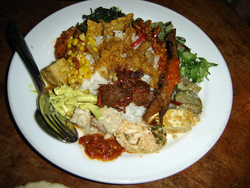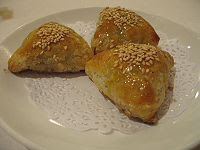Blackball (pool)
From Wikipedia, the free encyclopedia

A blackball kick shot in action
Blackball (sometimes written black ball or black-ball) is a pool (pocket billiards) game that is popular in the United Kingdom, Ireland, Europe and several other countries. In the UK and Ireland it is usually called simply "pool". The game is played with sixteen balls (a cue ball and fifteen object balls) on a small (6 ft x 3 ft or 7 ft x 4 ft) pool table with six pockets. Blackball is an internationally standardised variation of the popular bar and club game eightball pool (a.k.a. eight-ball pool or 8-ball pool), closely related to the originally American and now professionally internationalised game of eight-ball. The two main sets of playing rules are those of the World Pool-Billiard Association (WPA, the International Olympic Committee-recognised governing body of pool) and its affiliate the European Blackball Association (EBA), known as "blackball rules", and the older code of the World Eightball Pool Federation (WEPF), often referred to as "world rules".
Contents
1 History
2 Equipment
3 Rules
3.1 World Rules
3.2 Blackball Rules
4 World Championships
5 References
6 External links
History
Eight-ball pool (and thus its standardised form blackball), like international-style eight-ball, is derived from an earlier game invented around 1900 and first popularized in 1925 under the name B.B.C. Co. Pool by the Brunswick-Balke-Collender Company. Like blackball and eight-ball pool today, this forerunner game was played with seven yellow and seven red balls, unnumbered (in contrast to the international-style numbered stripes and solids, sometimes called kelly pool balls in the UK), a black ball, and the cue ball. The game had relatively simple rules compared to the modern game.[1][2][3][4]
Equipment

The triangle set-up
Plain unnumbered red (or sometimes blue[5]) and yellow colour balls are used in lieu of numbered solids and stripes common to international eight-ball and other pool games, which in the UK are usually called kelly pool balls. (Many suppliers refer to the yellows-and-reds ball sets as "casino" balls, whether UK- or US-sized, because they were briefly used in US casino-hosted, televised, modified eight-ball rules tournaments; the coloured rather than numbered sets were selected for their distinguishability on TV). The black ball, however, still typically bears a number "8" (a holdover from kelly pool), though numberless variants are not unknown. Balls are 2" in diameter.
British pool tables come in 6 ft x 3 ft or 7 ft x 4 ft varieties,[6] with 7 ft being the regulation size for pub pool league play. The table has pockets just larger than the balls and rounded, as in the game of snooker, whereas the American-style table has pockets significantly larger.
Tournament rules may require the presence of more than one type of rest, again adopted from snooker.
Rules

An example set-up of the triangle for break-off; the 8 ball is on the pyramid spot.
There are two competing standards bodies that have issued international rules. The older, and currently dominant, of the two sets in English style pool are the World Eight-ball Pool Federation (WEPF) rules (often called "World Rules").[7] The majority of WEPF members come from the UK and Ireland, and from current and former Commonwealth of Nations countries, plus Belgium.
A competing but very similar set of rules has been promulgated by the World Pool-Billiard Association (WPA), under the game name "blackball" to better distinguish it from the American-style game (for which WPA also promulgates rules),[5]. It was intended that "blackball" would unify the various existing English-style rulesets (presumably also including the WEPF rules) although this has not yet happened. The self-described "governing body" for WPA blackball in Europe, with numerous national and local affiliate groups, is the European Blackball Association (EBA).
World Rules
The balls are racked with the black (the 8 ball) on the foot spot (or "black spot"), in contrast with US-style eight-ball, nine-ball and most other pool games, in which the apex ball is placed on the foot spot. A "fair break" is one in which an object ball is potted, or at least 2 object balls pass the imaginary line that goes across the middle pockets. If the black is potted, the game is restarted with a re-rack, broken by the original breaker. If the cue ball is potted on an otherwise fair break, it is a "non-standard" fault (foul) that simply ends the breaker's turn, with no further penalties. If it is a foul (non-fair) break, the incoming player gets two visits as with other "standard fouls" (see below), and gets to break, after a re-rack, without the option to instead play the balls as they lie. Openness of the table (unlike in the American-style game) does not last long, in that if the breaker pots a ball on the break from one group, and elects to continue shooting that group, then that group are his/her balls-on, even if the post-break followup shot is missed, while if the group chosen did not have any balls potted on the break, the table remains open until a ball is legally potted (does not matter if legal or illegal shot by pocketing the cue ball), (while if no balls were potted on the break, the table is of course open). While the table is open, the shooter must nominate what group (s)he is shooting for.
A legal (non-break) shot is one where the cue ball first hits a "ball-on" (one of the balls in the player's own group), and does not pot the cue ball, the black or any of the balls in the opponent's group, and either one of the shooter's balls-on is pocketed, or a (any) ball contacts a cushion after the cue ball contacts the (first) ball-on. I.e., it is the same as in American-style, but with the additional requirement that one not sink an opponent's ball (doing so is a fault), and lacking the requirement that ball and pocket have to be called (i.e. slop shots are perfectly valid, even on the black.) There are other forms of fault, generally the same as in other pool games, such as potting the cue ball (except on the break, as noted above), knocking balls off the table, moving balls accidentally, double-hits and pushes (though the standards are weaker than in American-style rules), unsportsmanlike conduct, etc. There are also other unique fouls such as the requirement (borrowed from snooker) to shoot away from any ball that the cue ball is frozen to, without moving it (however if the frozen ball is the shooter's own, it counts as contacting a ball-on, and only a (any) ball must reach a rail for it to be a legal shot. As in informal American bar pool, but not WPA/BCA/IPT standardized American-style rules, players are sometimes required to take certain shots (besides the break shot) from baulk or "the kitchen", i.e. from behind the baulk line (head string), shooting forward across it. Also, all jump shots that result in missing an intervening ball are faults.
After a fault, the offending player will effectively miss a turn and give the opponent two visits. These free shots must be taken from baulk, unless the cue ball was potted, in which case the incoming player has ball-in-hand anywhere. The second free shot can be taken from baulk even if a legal ball was potted on the first post-fault shot; this is known as the "two-shot carry" rule.
There are other unique rules, such as a relaxation of the legal shot requirements when the shooter is "totally snookered", a prohibition against using either the cross or spider rest whilst the player is attempting to pot the black, and special handling of a snooker that resulted from an opponent's foul, such that the incoming player can elect to shoot the black or an opponent's ball first in attempting to pot his/her own ball-on, and can even pot both the black and the opponent's ball if the incoming player is on the black.
It is a loss of frame (game) to fault in any way while actually potting (but not just shooting at) the black.
Blackball Rules
Blackball rules are very similar to the "World Rules". One notable difference is that after the opponents fault player has a free shot (he may take the cue ball in position or in hand in baulk, "wrong ball first" rule is suspended) plus next visit (he continues playing even if no ball or opponents ball was potted).
World Championships
Both World Pool-Billiard Association (with PPPO and EBA) and World Eight-ball Pool Federation currently sanction the World Championships. As of 2010 WPA World Blackball Champion is Jayson Shaw from Scotland and WEPF Eight-ball Pool World Champion is Mick Hill from England.
For more information see: List of Blackball and "British-style" eight-ball pool champions
References
^ Shamos, Michael Ian (1993). The Illustrated Encyclopedia of Billiards. New York, NY: Lyons & Burford. p. 85. ISBN 1-55821-219-1.
^ Jewett, Bob (February 2002). "8-Ball Rules: The many different versions of one of today's most common games". Billiards Digest Magazine: Page 22–23.
^ Hickok, Ralph (2001). "Sports History: Pocket Billiards". HickokSports.com: Everything You Wanted to Know About Sports. New Bedford, MA, USA: self-published. Retrieved 13 December 2006.
^ Shamos, Mike (1995–2005). "A Brief History of the Noble Game of Billiards". Broomfield, CO, USA: Billiard Congress of America. Retrieved 13 December 2006.
^ a b "World Pool Association [sic] Blackball Rules", World Pool-Billiard Association, 2005.
^ "British vs. American Pool". Retrieved 30 April 2010.
^ "World Eight-ball Pool Federation Eight-ball Rules", 2004, Perth, WA, Australia
External links
World Pool-Billiard Association (WPA) — world governing body for numerous versions of pool, including "blackball rules"
European Blackball Association (EBA) — Europe's WPA-affiliate organisation for blackball
Associació de Blackball Catalunya — Catalonian organisation for blackball
World Eightball Pool Federation (WEPF) — international governing body for "world rules"
Welsh Pool Association (WPA) — international governing body for pool in Wales.









